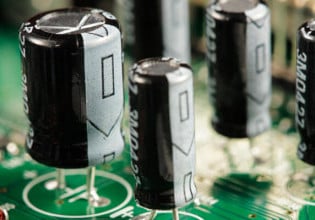Flurry of Product Releases Punctuate Busy Week at Electronica
As the Electronica 2010 Electronics Fair drew to a close, several major product releases and announcements highlighted a successful week.
Exar Corp. unveiled the XRP7664, a new synchronous Pulse Width Modulation (PWM) step-down converter with a maximum load current of 2A and operating input voltage of up to 18V. This device is the latest addition to Exar’s industry acclaimed PowerBlox family of high-voltage, high-current step-down regulators. Optimized for a 12V input voltage rail, yet equally capable of operating from the popular 5V rail, the XRP7664 addresses the needs for smaller footprint and substantial savings in cost sensitive applications. These include audio-video equipment such as set-top boxes, telecom, computing peripherals and more generally distributed point-of-load conversions.
Avago Technologies announced a new optocoupler available in special packages designed for use in renewable energy applications. The new ACNV4506 optocoupler provides robust electrical signal isolation as an Intelligent Power Module (IPM) interface or Insulated Gate Bipolar Transistor (IGBT) gate drive in wind turbines, renewable energy harvesting sites and other industrial control applications.
The ACNV4506 optocoupler is available in a 500 mil 10-pin dual-inline package (DIP) as well as a gull wing lead option for standard surface mount processes, both with 13-mm creepage and clearance that meets the IEC60664-1 standard. The package improves isolation performance with minimum common-mode rejection (CMR) of 30 kV/s for superior noise toleration, resulting in smoother control with less torque ripple in motor control applications. The device operates in harsh working environments in the -40 to +105°C extended industrial temperature range, and also targets ac and brushless dc motor drives and industrial inverters.
ZMD AG announced its strategic cooperation with Fairchild Semiconductor to develop energy-efficient power-management solutions for a range of point-of-load (POL) applications. According to the agreement, ZMDI’s advanced digital point-of-load technology, in conjunction with Fairchild’s XST™ DrMOS technology, will provide highly energy-efficient power-management solutions for applications such as base stations, telecommunications switches, network routers, servers, storage and industrial personal computers (PCs).
Fairchild Semiconductor also announced the development of the AccuPower™ load switch series, the industry’s first 2.8V to 36V integrated load switches, intended to address the designer’s mid-voltage needs. Devices in the AccuPower series of load switches include the FPF2700, FPF2701 and FPF2702. Unlike current solutions that require discrete MOSFETs plus external protection circuitry, devices in the AccuPower series of load switches feature built-in protection to eliminate as many as four additional devices, saving over 70 percent board space.
Plessey Semiconductors announced the release of the PS2292X family of low dropout linear regulators for point of load applications. The devices are part of a high current, single supply LDO family that operates from an input voltage as low as 1.7V. Targeted for industrial, medical, communication, computing and consumer markets, the regulators are an ideal choice for low voltage post regulation applications. The new line of regulators offers fast transient response while maintaining high Power Supply Rejection Ratio (PSRR).
Other key features include ON/OFF control, output voltage accuracy of ±1%, power good with 500Bs delay, ByPass pin for ultra-low noise, over temperature and over current protection. With a unique circuit trimming approach, the regulators offer custom delivery of voltages in 100mV increments in the range of 0.5 to 5V within four weeks of receipt of order.
NXP Semiconductors N.V. announced the EM773 energy metering IC, which the company says is the world’s first 32-bit ARM®-based solution designed specifically for non-billing electricity metering applications. In recent years, Advanced Metering Infrastructure (AMI) and smart meters have become popular with regulators and utilities as a means to introduce more sophisticated pricing models and tariffs, and incentivize customers to adjust their energy consumption accordingly. The NXP EM773 takes energy metering beyond this traditional billing context, by making it easy for system designers to integrate energy metering functionality into almost any type of device, and make information on electricity consumption more accessible and intuitive for the end user.
With the EM773, consumers and industrial users can monitor energy consumption in real-time, in devices ranging from smart plugs, smart appliances and green consumer electronics, to building sub-meters, industrial sub-meters, and even clusters of rack-mounted servers in the data center. Featuring a metrology engine with automatic single phase, power and energy measurement, the EM773 energy metering IC includes an API which vastly simplifies the design of non-billing metering applications. The NXP EM773 is built on an ARM Cortex&™-M0 processor.
Maxim Integrated Products introduced the MAX16975 automotive-grade, 1.2A step-down converter optimized for operation over a 3.5 to 28V range. To accommodate extreme battery voltage variations in automotive applications, the device tolerates load-dump transients up to 42V and cold-crank excursions down to 3.5V. It can operate in dropout by turning on the integrated 300mΩ high-side FET for the duration of cold-crank or start/stop events. The wide input supply range, combined with an ultra-low quiescent current (45µA, no load), makes the MAX16975 well suited for automotive applications that have tight power budgets.
The MAX16975 features a resistor-programmable switching frequency (220kHz to 1MHz) that can be tuned to suit the demands of the application. It can also be synchronized to an external clock. Additional features include an open-drain power-good output with adjustable reset threshold and delay timer, as well as protection features such as cycle-by-cycle current limiting, thermal shutdown, and overvoltage protection.






